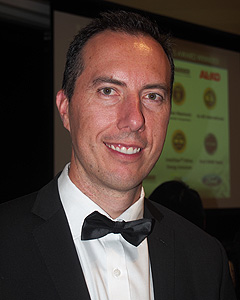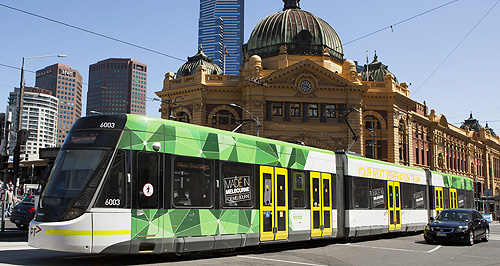News - General News - PeopleAuto engineers kicking goalsPeople mover: Tram and train-maker Bombadier is encouraging engineers from the automotive sector to look at a career in transport engineering. Photo credit: Yarra Trams Tram, train maker benefits from automotive expertise in development and production23 Nov 2015 By IAN PORTER FORMER automotive engineers are continuing to make a difference in other transport fields, this time with Victoria’s largest tram and train producer, Bombardier. In this case, former GM Holden employee Steve Brooks has made a big impression by rejigging Bombardier’s testing and validation procedures, according to the company's director of sales and marketing Ben Phyland. Mr Phyland said that young graduates in automotive engineering and design should consider careers in other transport fields such as rail and heavy vehicles if they do not land one of the few jobs at Ford Australia and GM Holden. He said the improvements in Bombardier’s testing and validation procedures have been a major boost for the company because trams designed to run on Melbourne’s old rail network have to be so tough that Bombardier engineers refer to them as “off-road trams”. Mr Phyland, a graduate of RMIT University where he trained as an industrial designer specialising in automotive design, was speaking at the SAE-A Mobility Engineering Excellence awards, where Bombardier won the gold award in the rail category.  Left: Bombardier director of sales and marketing Ben Phyland Left: Bombardier director of sales and marketing Ben Phyland“In the last couple of years we have had some fantastic engineers come in from Toyota and Holden,” he said. “They have brought in some very new ideas and have adapted some of the skills they have learned, being entrepreneurial and innovative-type guys.” There have been several recent instances where automotive industry training has produced positive results in other sectors or industries. Little more than a year ago, some Toyota engineers were set the task of remodeling the system used by St Vincent’s Hospital to package medications for its patients. They cut the average time taken to package each script from 210 minutes to 34 minutes, an 84 per cent improvement. Toyota received calls from several other hospitals after the St Vincent’s project was completed. Mr Phyland told the audience at the SAE-A Mobility Engineering Awards evening that Mr Brooks’ skills in pre-production quality assurance had been a “real revelation” at Bombardier. He said the traditional system at Bombardier was not to build a prototype. “We don’t test a lot. We build the first one and then make it work.”“Steve has brought a lot more testing and process validation before we build it. So that helps to make sure we get something right rather keep modifying something until it comes right.” Mr Brooks is currently in India, helping Bombardier prepare to start production of a $4 billion train contract awarded by the Queensland government. “We have a massive contract with Queensland Rail, 450 carriages, and we have transferred him over to India to help the Indians learn how to check the design of the train, the model, to build it, because they are upgrading and transitioning to a digital platform.” Mr Phyland said the huge contract was initially awarded to Bombardier’s Australian operation and the trains were going to be built in the Dandenong plant. But when the Queensland Labor government lost the election, the incoming Campbell Newman government changed the tender by omitting the local content requirements. The Bombardier group won the altered contract, but had to switch construction to its Indian operation to do so. Mr Phyland said other automotive engineers who have joined Bombardier had helped improve the company’s quality. “We have also had some electrical engineers who have come in who have worked on wiring looms for cars, which are quite complex. “Trains are also very complex, but much bigger and we have adopted some pre-assembly testing techniques from automotive to rail. Traditionally we have done point-to-point tests on the wiring loom, then stuck it in the train, connected it up and then tested it. “Now we are pre-testing, connecting everything off the vehicle, on the wiring loom. We are effectively testing a whole train on the computer, making sure all the faults are corrected on the wiring loom before we actually install it.” Mr Phyland said there are thousands of electrical connections on every train, and every one of them is a potential fault. Bombardier has hundreds of engineers spread across its Victorian and Queensland operations and he said it was important that trams and trains were designed for local conditions. “We can’t sell an Australian-designed vehicle overseas but, by the same token, we can’t bring in a European-designed vehicle because they won’t work here. “They won’t survive the temperature in summer, they fall apart because of the rough track. “A good example of that is our tram in Melbourne. It’s what we call an off-road tram. It’s a hardcore, Aussie-style rough-rail tram. “To do all this, we need a lot of engineers and designers and this is a final message for the younger engineers in the audience. I ask you to think about what you want to do and how you can contribute to the mobility industry. “Congestion is not going to go away. Improving services is always there. If there is not an opportunity to design cars, what else can you do? Buses, trucks, trains: there’s plenty of opportunities out there.”  Read more |
Click to shareGeneral News articlesResearch General News Motor industry news |
















Facebook Twitter Instagram